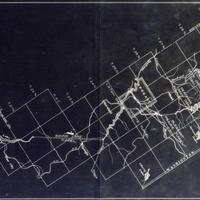Map of main canal, gravity plan (1923)
Title
Map of main canal, gravity plan (1923)
Subject
Irrigation -- Washington (State) -- Maps<br>Columbia Basin Project (U.S.)
Description
1 map ; negative, 13 x 35 cm.<br> Before the arrival to Washington State of the first irrigation projects handled by the U.S. Reclamation Service, the Northern Pacific Railroad and other railway companies funded private irrigation projects in the Columbia River Basin. Their efforts stemmed from a desire to see the entire state in top production and farming communities everywhere in need of railroad shipping services. <br>The project was much too large for one railroad company or town, or other private investor to take handle. By 1919, a number of government agencies (both state and federal) reviewed irrigation plans for the area. These were shortly resolved into two possibilities: the "Gravity Plan", pushed by the city of Spokane and the Washington Water Power Company, and the "Pumping Plan" proposed by Billy Clapp of Ephrata and supported by the surveys of Mr. James O'Sullivan. The Pumping Plan involved the erection of a dam at Grand Coulee, giving water to an estimated 1,400,000 acres in the Big Bend country to its south. This map displayed the canal route of the Gravity Plan, which would build a low masonry dam on Pend Oreille River at Albeni Falls, Idaho and hold the waters at Pend Oreille Lake and Priest Lake, Idaho. The reservoir lay approximately forty miles from Spokane. The water would then be sent (by gravity) through a series of canals and tunnels, siphons and aqueducts--even lakes--until it reached the Big Bend country 130 miles below. This plan predicted water for the most amount of acres (1, 750,000) and was touted as economically feasible. <br>Throughout the 1920s, a number of survey reports weighing the feasibility of both plans were given, and approved the gravity plan over the pumping plan. However, the Corps of Engineers' "308 Report" compiled by Major John S. Butler, was the first to approve of the Grand Coulee (pumping plan) venture. When used as evidence in the House of Representative's hearing by the Committee on Irrigation and Reclamation, the tide had changed and the pumping plan was approved over the gravity plan. With this approval, in 1933 President Roosevelt signed for appropriation of funds made possible by the National Industrial Recovery Act and construction on the Grand Coulee Dam began soon after.
Creator
Dept. of the Interior, U.S. Bureau of Reclamation Columbia Basin Project
Source
Manuscripts, Archives, and Special Collections, WSU Libraries
Publisher
Spokane, Wash. : Dept. of the Interior, U.S. Bureau of Reclamation
Date
1923
Contributor
Manuscripts, Archives, and Special Collections
Rights
Contact Manuscripts, Archives, and Special Collections, for copyright information 509 335-6691
Relation
Is part of Osmer L. Waller Collection; Cage 222, Box 5<br>http://www.wsulibs.wsu.edu/holland/masc/finders/cg222.htm
Format
image/jpeg
Language
English
Type
Maps
Identifier
wsu510<br>Osmer L. Waller Collection; Cage 222, Box 5
Coverage
United States--Washington (State)
Collection
Citation
Dept. of the Interior, U.S. Bureau of Reclamation Columbia Basin Project, “Map of main canal, gravity plan (1923),” Digital Exhibits, accessed February 21, 2025, http://752800.40daj.group/items/show/1996.
